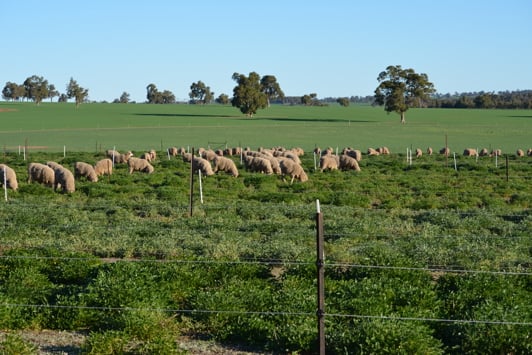Sheep productivity, health and welfare can be held at acceptable levels if feed and water supply matches demand. The department has a comprehensive range of information resources for producers wanting to achieve good management of livestock.
Most pastures in south-west Western Australia are comprised of annual species, growing in the Mediterranean climate cool wet winters, and senesced in the warm to hot dry summers. This inevitably means that there are periods in the year where pasture supply and livestock demand do not match:
Autumn: There is little dry feed left after summer, and pastures germinate after the first rains in a cooling trend. This period is often termed the 'feed gap'. See supplementary feeding below.
Winter: If pastures have established well in autumn, there is enough feed on offer and the pasture growth rate keeps pace with livestock demand.
Spring: Pastures grow rapidly in this period of adequate soil moisture and increasing day length and temperatures. Feed on offer and pasture growth rates are usually much higher than livestock demand. This 'excess' growth matures and provides a feed resource over summer.
Summer: Pastures are dry, and are gradually trampled, eaten and lose their soluble components with any rain. Nutrition of pregnant ewes needs careful monitoring over this period, as feed supply is decreasing and feed demand is increasing.
Supplementing pasture feed in autumn is standard practice. Supplements include grains from cereals and pulses, hay, and manufactured pellets.
In drier than usual seasons, supplementary feeding may extend for long periods. A dry winter and spring means that supplementary feeding may be needed from early in summer through until pasture grows in winter.
A dry autumn and winter means that the 'feed gap' may last for many months, and also result in less feed available over summer.
Budgeting
Feed budgeting should be part of a livestock management plan, which can include things like livestock sales, agisting, and feedlotting. We also recommend doing a livestock water budget at the same time.
We recommend doing a feed budget for the full year: matching feed supplies with feed demand, and accounting for seasonal risk.
Agistment is an option for removing livestock from a property, for a number of reasons – after a fire, when paddock feed is inadequate, to spell pastures, or to finish livestock for sale on better feed.
Related information
- Sheep management and reproduction
- Supplementary feeding calculator for pregnant and lactating ewes
- Sheep tools, calculators and resources
- Pastures and grazing
- Water quality for livestock
- Analysis of the value of a ewe in the WA sheep industry
- Feeding and managing sheep in dry times
- The good food guide for sheep: feeding sheep for meat production in the areas of Western Australia
- Drought feeding and management of sheep (2018)
- Lifetimewool: Tools for managing your ewe flock
- Subscribe to the Ovine Observer newsletter
- Subscribe to the StockedUp livestock newsletter

